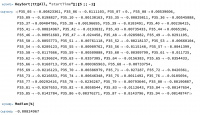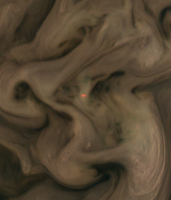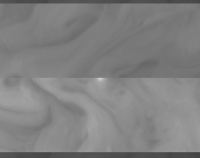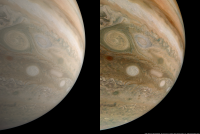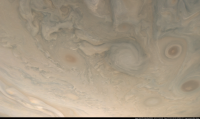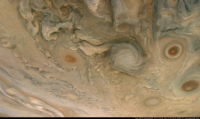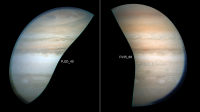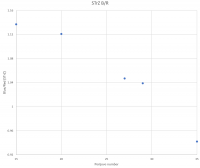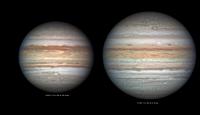Printable Version of Topic
Click here to view this topic in its original format
Unmanned Spaceflight.com _ Juno _ Juno Perijove 35 - Jupiter
Posted by: mcaplinger Jul 22 2021, 10:12 PM
First group of images, including Ganymede, now on missionjuno. More to follow.
Posted by: Bjorn Jonsson Jul 24 2021, 12:35 AM
Is anyone else getting very large values that must be added to the START_TIME of the PJ35 Jupiter images to get correct limb positions? Instead of the value 61.88 msec (+/- possible jitter) I apparently need to add something like 120 msec. This is *much* larger than I have ever seen before. I have checked and double checked everything for two images (pj35_55 and pj35_71) without finding anything wrong in what I'm doing. I downloaded the new version of the SPK kernel juno_pred_orbit.bsp that was released today - it didn't result in any significant changes. I also tried running one of the PJ34 images through my processing pipeline but the results were correct/normal so on my end this is something specific to PJ35.
Either I'm messing something up or there are unusually large errors in one or more kernel files released following PJ35.
Posted by: Brian Swift Jul 24 2021, 05:55 AM
My "quick" limb fits look OK to me.
Posted by: Brian Swift Jul 24 2021, 06:03 AM
So I wonder if this is a daytime lightning flash in P35_53 red filter.
Crop of processed Image:
Crop of raw:
Posted by: mcaplinger Jul 24 2021, 08:28 PM
Not saying this is your issue, but I'll note that any use of a C kernel relies on having an up-to-date SCLK-SCET kernel, even if you're not making any explicit use of SCLK values otherwise. I've been burned by this several times.
Posted by: Bjorn Jonsson Jul 26 2021, 12:49 PM
In this particular case this was not my issue but this is something familiar. I always check for this if I get weird results.
Are these numbers error estimates from limb fits? I also get good/normal results from limb fits once I add ~120 msecs to START_TIME. The resulting processed images also look normal (e.g. nothing strange at the limb and no color channel alignment issues). What I'm suspicious about is the value 120 msecs which is unusually large. Which value are you adding to START_TIME for e.g. image PJ35_71?
Posted by: mcaplinger Jul 26 2021, 03:27 PM
What kernels are you using? I'm seeing an offset of about 30 msec for that image using spk_pre_210607_211016_210712_otm35_p.bsp and juno_sc_rec_210720_210721_v01.bc
Posted by: Brian Swift Jul 26 2021, 05:56 PM
The values are my additive start time adjustments in seconds. So, for PJ35_71 I'm adding -27ms to start time.
Cavet: this is using my camera model so there may be a small bias relative the standard model.
But the the numbers show there is no excessive time shift on the order of the 120ms you are experiencing.
SPICE kernels I'm using:
'$JK/pck/pck00010.tpc'
'$JK/sclk/JNO_SCLKSCET.00117.tsc'
'$JK/fk/juno_v12.tf'
'$JK/ik/juno_junocam_v03.ti'
'$JK/spk/de440s.bsp'
'$JK/spk/jup363.bsp'
'$JK/spk/juno_struct_v04.bsp'
'$JK/spk/juno_pred_orbit.bsp'
'$JK/spk/spk_rec_131005_131014_131101.bsp'
'$JK/spk/juno_rec_orbit.bsp'
'$JK/ck/juno_sc_rec_210720_210721_v01.bc'
Posted by: Bjorn Jonsson Jul 26 2021, 10:51 PM
Thanks to Brian and Mike for the information above. Should be sufficient for me to eventually determine what's going on. Very weird since everything seems normal for PJ34 and also earlier perijoves. In particular everything works perfectly where IMG/LBL files (and therefore accurate START_TIMEs) are available.
I was using juno_pred_orbit.bsp. Using spk_pre_210607_211016_210712_otm35_p.bsp instead resulted in only a small change (the difference in spacecraft position is just a few hundred meters for the image I tested).
In the meantime I decided to proceed with my processing of the PJ35 images and not wait until I've found exactly what's happening. Should be OK since this strange problem has no significant effect on the resulting processed images. This is a part of image PJ35_71 in an approximately true color/contrast version and an enhanced version:
This is an interesting image since a lot of spots of various sizes, colors and shapes are visible in a relatively small area. The biggest spot is Oval BA.
Posted by: Bjorn Jonsson Aug 2 2021, 12:15 AM
This is a part of image PJ35_55 in approximately true color/contrast and enhanced versions:
BTW I have noticed that the images from recent perijoves are probably slightly redder than earlier images. I suspect the reason might be a lower amount of scattered light in the images due to a different viewing/illumination geometry (or possibly the scattered light distribution is different now). Bad bias correction or bad flat fielding is a possibility I have eliminated. Another possibility is that the camera sensitivity and/or filter transmission has changed but I think a lower/different amount of scattered light is more likely.
Because of this I changed the color correction multipliers when processing the PJ35 images, in effect brightening green by ~4% and blue by ~6% relative to the values I have been using for recent perijoves. This correction is preliminary and may need to be increased.
Posted by: Brian Swift Aug 2 2021, 07:08 AM
By "scattered light" do you mean light scattering in the Jupiter's atmosphere, or light scattering within the camera sensor area?
Posted by: Bjorn Jonsson Aug 2 2021, 11:49 AM
The latter.
Posted by: Bjorn Jonsson Aug 4 2021, 03:20 PM
Here is an example of the color change I'm seeing from PJ20 to PJ35. The processing is identical for these two images. I checked the processing pipeline and can't see anything there that explains this difference so I'm pretty sure this is not a bug in my processing pipeline. In particular, the color multipliers are identical in these two cases.
In addition, at a quick glance the color I get at PJ27 is roughly intermediate between the PJ20 color and the PJ35 color.
Posted by: mcaplinger Aug 5 2021, 08:21 PM
Probably a real change of Jupiter's. For example, https://britastro.org/node/25892 says
Posted by: Bjorn Jonsson Aug 7 2021, 02:38 AM
I seriously doubt this since AFAIK the color change mentioned there is confined to the Equatorial Zone but the reddening I'm seeing is global.
I have now verified with pretty good certainty that this color difference between PJ20 and PJ35 is present in the raw images. Assuming that these measurements from the raw PJ20 and PJ35 images are correct, a bug in my processing pipeline has been almost completely ruled out.
It would nevertheless be very interesting if someone (Brian maybe?) would process the PJ20_40 and PJ35_68 images and use identical color correction for PJ20_40 and PJ35_68. If the result is similar to mine (i.e. redder PJ35) it would completely rule out a bug in what I'm doing. A confirmed color change would be an interesting result regardless of what's causing it.
Posted by: Brian Swift Aug 7 2021, 04:56 AM
Here you go. Same processing run, same/fixed/constant brightness setting, linear to sRGB encoded 16-bit, 5292 × 7162 16-bit png available in Flickr download:
https://flic.kr/p/2mfG8xPhttps://flic.kr/p/2mfG8xP
Posted by: Bjorn Jonsson Aug 7 2021, 02:36 PM
Thanks! This is very similar to what I am getting and seems to confirm that there is a color change from PJ20 to PJ35. Here is a plot from a few images I processed. It shows the blue/red ratio in the South Tropical Zone (STrZ) for several perijoves. This is from decompanded images. There are some inaccuracies due to various factors (for example the illumination geometry varies a bit) but the trend is clear. The units are arbitrary in the sense that I didn't attempt to make B/R=1 for any specific perijove. As noted above, this is the STrZ but everything else in the images has also been getting redder.
The images are clearly getting redder.
Interestingly, the 1600x1600 pixel map projected color images released at the missionjuno website together with each raw image have not been getting redder. Now I am wondering how the color is corrected in these map projected images.
Posted by: mcaplinger Aug 7 2021, 05:11 PM
They are simply white-balanced using a gray-world algorithm.
Posted by: Brian Swift Aug 7 2021, 05:56 PM
I believe the the missionjuno images include a correction for illumination intensity change due to change in SOLAR_DISTANCE.
JNCE_2019149_20C00040_V01.json: "SOLAR_DISTANCE": "7.9340e+08 <km>",
JNCE_2021202_35C00068_V01.json: "SOLAR_DISTANCE": "7.5293e+08 <km>",
So, Jupiter has gotten about 5% closer to the Sun, and illumination has increased by about 11%.
But I don't see how that would lead to reddening. (Unless a SOLAR_DISTANCE correction was only being applied to one color channel)
Posted by: mcaplinger Aug 7 2021, 06:11 PM
Nope. The only files that use this value are the PDS-archived RDR files, which are all normalized for solar distance as described in the documentation.
The outreach map-projected RGB images on missionjuno have a lambertian shading correction applied and are then arbitrarily white-balanced, there is no explicit response function applied. The component map-projected images don't have the shading correction or the white balance, but are otherwise photometrically out of the camera (they have some blemish removal.)
Posted by: Floyd Aug 7 2021, 08:01 PM
If grey balanced, wouldn't that counter an increase in the averaged red channel? You may see your reddening in the un-grey balanced map-projected images.
Posted by: mcaplinger Aug 7 2021, 08:13 PM
Yes, certainly. And you can definitely see a color difference if you simply look at these two images in raw form.
The question is whether this is 1) a change in Junocam, 2) a change in Jupiter, or 3) a change in the illumination geometry. (I think we can rule out the illumination itself changing color.)
I vote for 2, and there are independent observations that suggest this is happening, at least for some areas.
One could perhaps look at the colors of the moons in various Junocam images over time to see if there has been a gross change in instrument response unrelated to the jovian atmosphere. Europa is probably the most color-neutral target.
Posted by: Bjorn Jonsson Aug 8 2021, 01:38 AM
I decided to process two Hubble images from calibrated data. I used an image from 2019-04-09 (a few days after PJ19) and an image from 2020-09-20 (a few days after PJ29). More recent data than 2020-09-20 was not available.
I deliberately didn't correct for Jupiter's rotation between the three exposures since doing so messes up the overall color balance a bit unless additional corrections are applied to the images. The lack of correction for Jupiter's rotation isn't a problem in large, low contrast areas like the STrZ - useful color measurements are possible there.
There is no obvious *global* color change here. In particular the STrZ has the same (or very nearly so) whitish color in both of these images.
These images are processed from images obtained with filters centered at 395 nm, 502 nm and 631 nm. This is not optimal for true color so the overall color in the above images is only approximate.
I also took a quick look at Ganymede's color in a PJ24 image vs. the color in a PJ34 image - luckily they have some common terrain coverage. I'm *probably* seeing some reddening in PJ34 compared to PJ24 but I'm not particularly confident in the accuracy of these measurements because of the low resolution of the PJ24 image.
I strongly suspect that the color change discussed in earlier posts is due to changes in illumination geometry and/or a change in JunoCam but I'm aware that none of the above conclusively proves that this is the case. I think it would be interesting to study this more deeply. I'm not so sure about the practical value of doing so though since I don't think the JunoCam images can ever be used for high-accuracy photometry of Jupiter.
Posted by: Bjorn Jonsson Aug 11 2021, 10:53 PM
Here is a quick comparison of southern hemisphere JunoCam images from PJ20, PJ29 and PJ35. The reddening in the PJ35 image compared to PJ20 is everywhere and not confined to specific belts or zones. IMO this is unlikely to be a real, global color change on Jupiter.
The processing of the three images is identical. They are not processed to make the color accurate/correct in any specific image. The main intention is to show the color change.
I'm seeing some tentative evidence that the reddening of the images may have started (or greatly accelerated) shortly after PJ20, possibly at PJ22. This is not easy to measure accurately though since the difference between two consecutive perijoves is small.
Posted by: JRehling Aug 12 2021, 03:44 PM
Here are images taken by Christopher Go in May 2019 and Aug 2021. I downscaled the images 2x as resolution isn't the point here.
As he's imaging from Earth, there's always the possibility of some random variation due to conditions on this planet, but it doesn't seem to show up discernibly in his work.
Aside from many individual features changing shape and size, it seems like things are close to the same. If anything, it looks like Jupiter is slightly bluer now than in 2019. FWIW.
Posted by: Bill Harris Aug 13 2021, 08:18 AM
What does Hubble show of Jupiter? I realize that HST is primarily used as a deep-sky instrument, but it has produced iconic planetary images, and it doesn't have atmospheric effects.
--Bill
Posted by: JRehling Aug 13 2021, 04:20 PM
As an instrument, HST is wonderful and could deliver a perfect answer to this, at least over the set of observations, which are more sparing than amateurs'. (HST may image Jupiter only about once a year, while amateurs image it every day apart from solar conjunction.) However, the public releases are not carefully controlled by any single set of creative choices and many public releases of HST images of the planets are obviously candy-colored reflecting varying aesthetic decisions by the image processing individuals and not real changes in the planets.
If someone would like to take raw HST images (which are publicly available) from two separate dates and process them in comparable fashion, that would give us a clean result.
Posted by: mcaplinger Aug 13 2021, 05:07 PM
Which Bjorn did back on post 23.
Posted by: JRehling Aug 13 2021, 10:40 PM
Indeed. My negligence in reading the thread only at the end, skipping what I missed earlier.
Posted by: fredk Aug 14 2021, 12:44 AM
About the colour shift, I don't know the details of the raw data or the processing steps: Is the raw data being used directly proportional to the intensity (up to nonlinearity of the sensor), ie no black-level offsets, companding, or gamma adjustments? And are all the processing steps being done linearly on the linear data, before converting to display gamma/sRGB at the final step? In particular any white balancing (RGB multipliers) or overall brightness scaling should be done on the linear data.
I'm wondering whether a combination of a brightening Jupiter as it approaches perihelion, coupled with some nonlinear processing steps, could account for the colour shift due to a different effect on different colour channels. I guess any actual sensor nonlinearity would be far too small to account for this.
Posted by: Brian Swift Aug 14 2021, 06:40 AM
Not necessarily a good metric, but an easy one to produce...
Here are color ratios from the per-perijove Radiation Trend Monitoring datatakes.
The ratios are of the 20th, 200th, and 2000th brightest decompanded (but otherwise unmodified) value
from each color channel.
If this metric is actually related to some physical phenomena, since both red/blue and green/blue ratios are increasing,
I wonder if issue could actually be that blue is decreasing.
Posted by: Bjorn Jonsson Aug 16 2021, 10:48 PM
I'm wondering whether a combination of a brightening Jupiter as it approaches perihelion, coupled with some nonlinear processing steps, could account for the colour shift due to a different effect on different colour channels. I guess any actual sensor nonlinearity would be far too small to account for this.
The only processing I did for the color comparison is decompanding and then multiplying the resulting R/G/B intensity with the same numbers everywhere to get something close to Jupiter's color instead of orange color. I omitted things like bias correction and flat fielding. The values I'm using are the values resulting from this. No conversion to display gamma/sRGB or stuff like that is involved. I also tried measuring intensity values directly from the raw images with comparable results (and one important thing to keep in mind: Never ever use Photoshop when doing photometry!).
The brightening of Jupiter due to the approaching perihelion shouldn't affect the color unless the camera is doing something very strange.
Here is a revised and augmented version of the plot I posted earlier:
This is the B/R ratio for 'clean' areas in the STrZ. The values prior to ~PJ20 are less accurate than post-PJ20 values for various reasons. This is especially true in the early orbits when JunoCam was imaging areas not very far from the terminator. These values are roughly comparable to Brian's results (at least after ~PJ20) even though what I'm doing is significantly different. I suspect Brian's numbers might be more accurate.
Posted by: JRehling Aug 17 2021, 12:09 AM
Just a bit of a wild / educated (?) guess… but is it possible that the material used for one of the filters is degrading in response to long term radiation exposure, which would, if it destroys the filtering properties, gradually broaden/whiten the spectral response curve of that filter? Or, alternately, such a process could be darkening one of the filters.
Posted by: Bjorn Jonsson Aug 17 2021, 12:24 AM
That's one possibility I think. Another possibility is that the lens might be becoming slightly brownish due to radiation. Or some combination of these and other effects.
Posted by: mcaplinger Aug 17 2021, 03:06 AM
The filters are interference coatings on rad-hard fused silica substrates. If you look at figure 15 in the Junocam paper, we intentionally went to some lengths to use rad-hard glass for the first five elements, and the non-hard elements have a lot of titanium shielding around them. And the CCD (and filters) are enclosed in a copper-tungsten housing. https://www.missionjuno.swri.edu/pub/e/downloads/JunoCam_Junos_Outreach_Camera.pdf
We have little idea of what actual total dose the instrument has seen, but we certainly weren't anticipating any gross optical effects like browning. And if we did see those, one would expect it to be gradual and cumulative, unless a single perijove pass got a large fraction of the overall total dose. I don't think there's any evidence of that, but I'm not really current on what the results of the radiation monitoring effort are.
Posted by: Bjorn Jonsson Aug 17 2021, 01:23 PM
Thanks. A crude way to estimate the radiation dose might be to count spikes/bright pixels in the images.
I'm still wondering about scattered light. I suspect it might be possible in theory to construct a 3D model of JunoCam and the spacecraft components that directly or indirectly can scatter light into the camera and then use some sort of ray tracing to construct an accurate model of scattered light, including its color, for each image. I imagine this would be extremely complicated and a lot of work to do and the practical value limited since it is usually rather trivial to determine the approximate correction per perijove required to process the raw images into approximately true color.
Here are color ratios from the per-perijove Radiation Trend Monitoring datatakes.
The ratios are of the 20th, 200th, and 2000th brightest decompanded (but otherwise unmodified) value
from each color channel.
Did you take into account that parts of these images are usually overexposed/saturated?
I ended up multiplying the red values by 1.0, green values by 1.27 and blue values by 3.05 to correct the color of the PJ35 images. This is a part of image PJ35_57 in approximately true color/contrast and enhanced versions:
Posted by: JRehling Aug 17 2021, 02:18 PM
I've dealt with scattered light far too often in my astrophotography and one thing that's always been true in my experience is that it is never isotropic across an image, but varies in ways that leave it visible, even if often hard to correct for.
JunoCam images of Jupiter are, in that respect, like a terrestrial telescope's experience of the Moon, which fills much/most of the FOV and can bleed a lot of scattered light outwards. The thing it, that produces ghosts in the blackness around the Moon, but usually has minimal effect in altering the image of the Moon itself because it is of a second order of brightness far below that of the primary image itself.
Perhaps an interesting test here would be Ganymede. Do the images of Ganymede (Io, Europa) taken before 2021 show a different color balance than the images from 2021? The lesser resolution should not be an issue here. And any geometry regarding sources of light outside the FOV would be very different for Ganymede pointing than for Jupiter pointing. Any change in the imaging hardware itself would affect all targets.
Posted by: mcaplinger Aug 17 2021, 03:26 PM
Unfortunately it's hard to correlate radiation effects in the sensor like this ("displacement damage dose") to overall radiation dose that damages glass ("total ionizing dose".)
We see a slow increase in warm pixels but it's been very gradual (also hard to control for orbit-to-orbit temperature variations.)
Posted by: mcaplinger Aug 17 2021, 03:28 PM
Bjorn did this already also, upthread. I would prefer to do it for Europa, but don't have convenient tools to identify photobombing moons.
Posted by: Brian Swift Aug 18 2021, 06:14 AM
Nope. The Radiation Trend Monitoring datatakes are completely wrong for this analysis. Don't know why I was thinking they were TDI 1.
The following shows ratios from three "brightest" TDI=1 Target=Jupiter datatakes for each perijove.
First graph has values on common scale. Subsequent graphs have separate scale for each color ratio.
"brightest" here being datatakes with largest value of 2000th largest raw blue value.
Ratios graphed are of 2000th largest red, green, and blue raw values in datatake.
Posted by: JRehling Aug 18 2021, 02:13 PM
That's a really nice result, Brian. One big takeaway is that at least two of the bands are showing signs of change; it can't be explained by just one alone, and that constrains both hardware and planetary explanations.
I wonder if there is any non-jovian-system object that ever photobombs the images, which would probably be more systematic in its appearances than the Galileans. I.e., Saturn (which has been comparatively near solar opposition as seen from Jupiter for the past several years) or one of the brighter stars. Vega, Canopus, Arcturus, etc?
Posted by: Brian Swift Aug 18 2021, 11:02 PM
Thanks, but I don't consider it a result, just data.
Now, rather than looking at ratios between colors, the below graphs show the image values (2000th brightests from 3 brightest TDI=1 datatakes per perijove).
The blue appears to be trending down since PJ25, with red and green also lower but not a clear visual trend.
These reductions are occurring while solar illumination is increasing (last graph).
The final table shows percentage reduction between PJ20 and PJ35 for each color.
Random speculation - alternative to radiation damage might be molecular contamination depositing onto optical components preferennetially reducing transmission of shorter wavelengths.
Posted by: Bjorn Jonsson Aug 18 2021, 11:28 PM
Very nice and I'm happy to see that various details (in addition to the general trend) in the R/B ratios are also present in the plot I posted even though I'm using a very different method to determine the ratio.
Posted by: Bjorn Jonsson Sep 3 2021, 12:47 AM
Details from image PJ35_58 in approximately true color/contrast and enhanced versions:
The large, grayish zone is the North Temperate Zone (NTZ). Some interesting and very subtle cloud patterns that seem to be mesoscale waves are visible in the NTZ in the upper half of the enhanced image. North is to the upper right.
And this is image PJ35_56 in approximately true color/contrast and enhanced versions:
North is to the lower left.
Powered by Invision Power Board (http://www.invisionboard.com)
© Invision Power Services (http://www.invisionpower.com)

